Dance and music were a profitable career and highly valued in ancient Egypt open to both men and women. Certainly, the ancient Egyptians were dance and music loving people. In addition, dancers were commonly depicted on murals, tomb paintings and temple engravings. However, they were more important than is generally thought. They were integral to creation and communion with the Gods. Were the human response to the gift of life and all the experiences of the human condition.
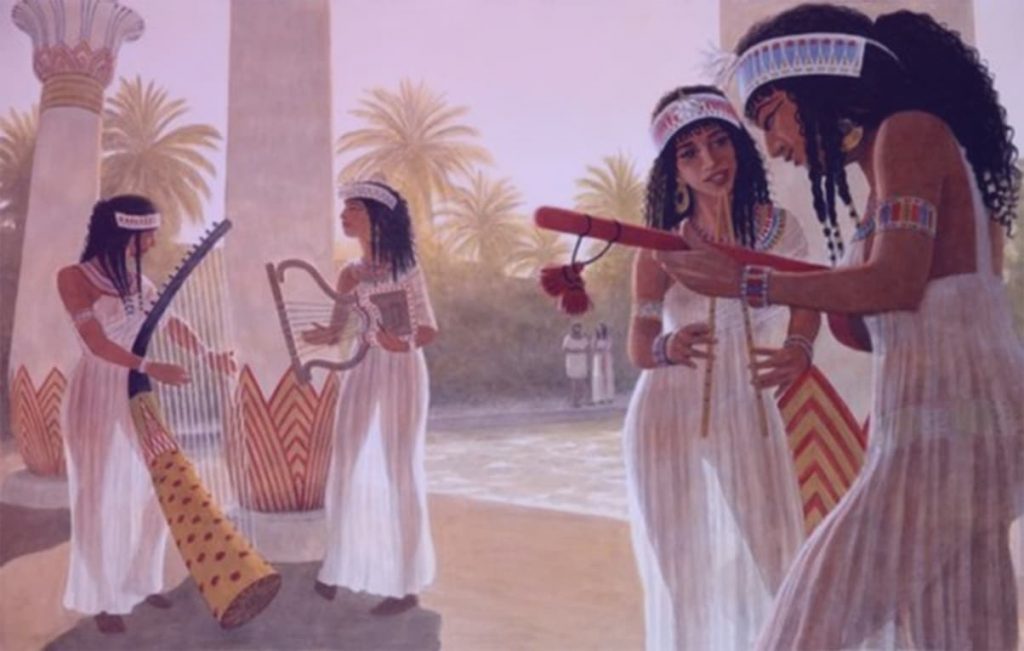
Egyptian woman play music in temple
Leisure time were filled with singing and dancing. As a result, farmers danced to give thanks for good harvests. Dance and music in ancient Egypt troupes were standard entertainment after dinner. Besides, music was everywhere in ancient Egypt at civil or funerary banquets. Also, religious processions, military parades and even at work in the field.
Dance and music were part of the Egyptian culture. In fact, featured prominently in religious ritual and ceremony. In fact, the study of ancient Egyptian dance is based mostly on identifying dance scenes from monuments, temples and tombs.
Dance & Dancers in Ancient Egypt
Dancing was an accepted part of life. In fact, a part of religious ritual. Also, sacred dances were directed to the goddess Hathor. But, also to Isis and Mut particularly Amun. Also to Min god of fertility and Maontus god of war. In addition, these dances were featured in Festivals.
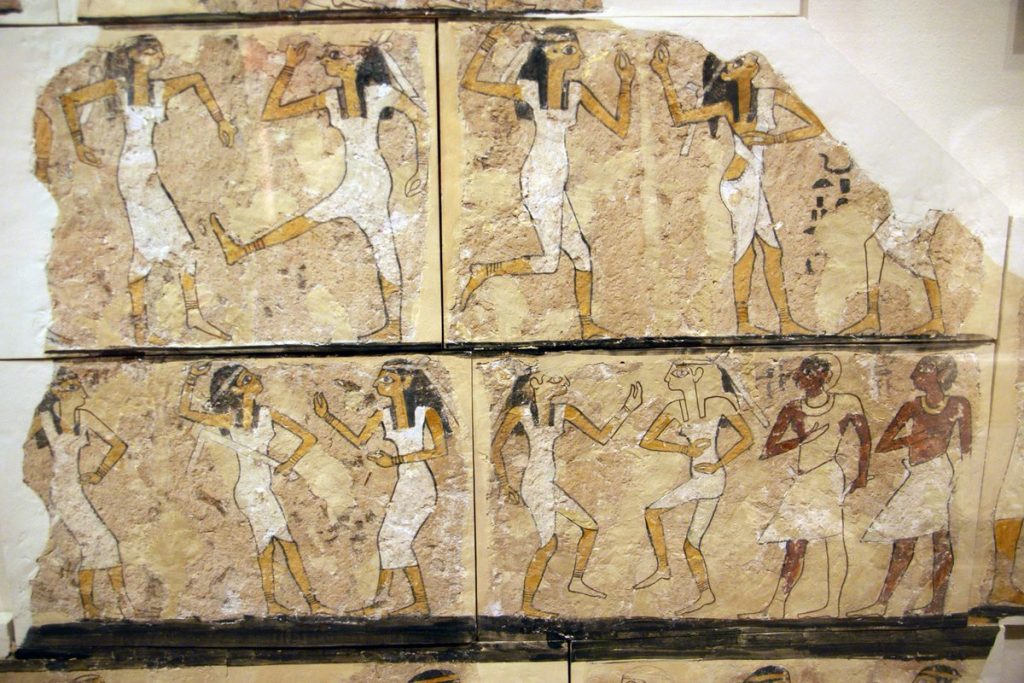
Tomb of the dancers wall 17th Dynasty Thebes
There were dances to honor The king. When he received foreign celebrities. And dances performed in association with the harvest and post circumcision initiation rites. Also, there were combat dances to entertain the king & queen.
Dance Culture
A suitably gifted woman could choose an honorable career as a dancer. In fact, in the Old Kingdom period. Female performing duo of Hekenu & Iti. Hekenu and Iti were not only musicians but also dancers. A popular duo ensemble or solo artist. Would give a performance at a set time and place. In fact, musicians regularly played in the market place and for laborers.
Some scholars believed that ballet moves such as the pirouette and arabesque originated in ancient Egypt
The oldest drawing of dance comes from pottery. However, the predynastic period (4000 to 3200 B.C.) from the Naqada culture. Depicts female figures dancing with upraised arms. In fact, dancers are joined by men brandishing clappers in what is thought to represent mourners in a funeral procession.
The corresponding noun dancer is a man standing on one leg. With the other leg bent at the knee. In addition, the icon graphical sources show both male and female dancers in a variety of contexts without exception. In fact, dancers who appear in pairs or groups are of the same gender.
Dance Evolution in The Nile Kingdom
Illustrated representations and written records from as early as 3000 BC. Are offered as evidence that dance and music have a long history in the Nile kingdom. However, their representation is available on reliefs and wall paintings in the tombs of private individuals. From the Old Kingdom to the end of the New Kingdom. dance and music were evolved over the years of the Nile kingdom.
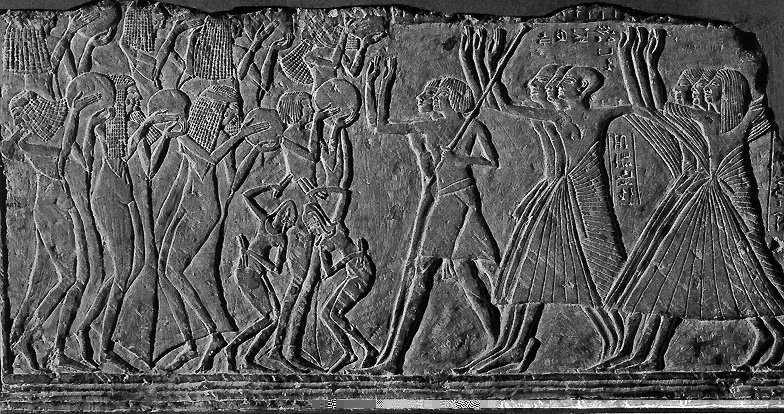
Two female dancers with castanets and musicians with tambourines
In the Old Kingdom. Dances tended to be formal and restrained. Clapping and percussion instruments used to set the beat. Meanwhile, In the Middle Kingdom leaps and stamping were introduced. However, in the New Kingdom dancing became more graceful and fluid. Also, when there appears to have been a greater variety of instruments. New types of rhythm instruments may have influenced the beat and the tempo of a performance.
The Old Kingdom
There are many depictions of dances from the Old Kingdom. But the depiction may vary a little. The dances were usually performed by women or young girls. One early dance for which there are images. However, shows a group dance by women with their arms raised above their head. Accompaniment is provided by women. Clapping and perhaps calling out. Also, some dancers performed nude and had unique ball shaped hair styles. Images of women in loincloths and braids doing deep backbend. Also, high kicks and other precarious.
The Middle Kingdom
Middle Kingdom dances included acrobatic dances. In which dancers laid on their stomachs, and reached their backs. Until their heads touched their feet. Erotic danced by skirted quartets of young girls. Representing the union of the Sun God Ra with Hathor. The mistresses of the sky. Large group dances with many men and women.

Women dancing to the rhythm of two women clapping hands
Dances in reliefs and murals. Show men doing pirouettes. Women mimicking the effects of the wind with their hands. One intriguing scene shows a man doing a squatting. Russian style dance. Finger snapping was added to the rhythmic sounds.
The New Kingdom
In the New Kingdom period. Dance scene show up frequently in banquet scenes and depict dance as much more joyous endeavour. They portray dancer and musicians in long filmy gowns. delicately affecting head, arm, torso or leg gestures. While playing the lute, flute, double oboe, lyre or tambourine. However, many dancers are girls, very young and nude and some of them black. Movements concentrated mainly on the upper body. Occasionally, using clappers.
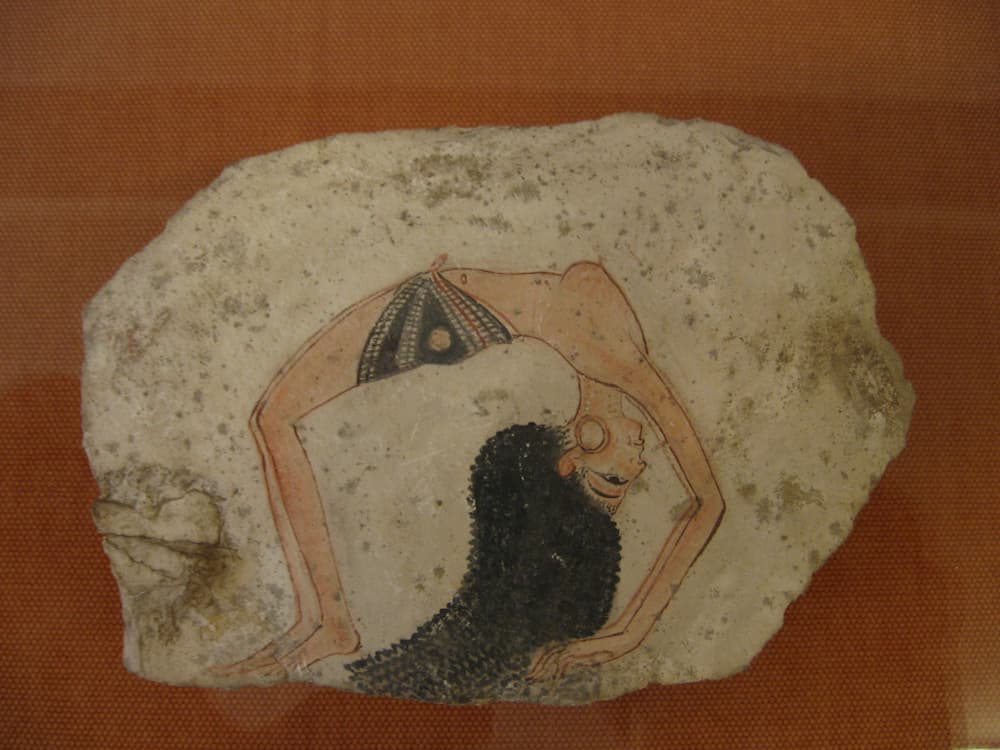
Figure of the acrobat dance on an ostrakon
In the New Kingdom. However, acrobatic dances featured cartwheels and forward flips. Funeral dances featured robed and naked women. Banging on tambourines in an agitated way. And thrusting forward their torsos.
One notable scene interpreted as a belly dance Which dignify fertility
A Greek guest at a royal banquet in Memphis wrote. Two dancers, a man and a woman. Went among the crowd and beat out the rhythm. Each danced a solo veiled dance. Then they danced together, meeting and separating. Then converging in successive harmonious movements.
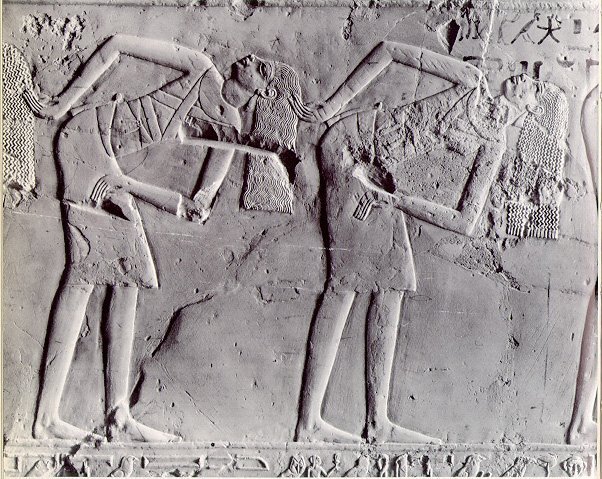
Two females dancers-1400 B.C-Sculpture-relief
The young man’s face and movements expressed his desire for the girl. As a result, the girl continually attempted to escape him, rejecting his amorous advances. The whole performance harmoniously coordinated, animated yet graceful.
Dance Festivals & Feasts in Ancient Egypt
Dance and music festivals in Ancient Egypt offered the opportunity to follow the heart. Breaking social and moral values or codes. This means that people were allowed to give into their impulses and their desires. Which was contrary to non-festival days. During which the heart should be kept under control.
They are several dance and music festivals in ancient Egypt. Among the festivals. During which dancing took place. There was nothing better than breaking the routine of life. With a grandiose festival for the ancient Egyptians. Religious or political. Festivals allowed both rich and poor to put away their cares for a day or two. And sometimes longer. To celebrate the best of ancient Egypt.
The Sed festival. Dances took place during jubilee ceremonies. Which celebrated the renewal pledge to the king. Therefore, such dances varied in accordance to the religious significance and the reflection of the local mythology of the God. To whom they were directed.
The Valley festival. Celebrates the God Amun’s trip. From Karnak temple. To visit the tombs on the West Bank. Passing by the sanctuary of Hathor. As the procession moved from one place to another. Families rejoined and danced.
The Opet Festival. A month-long Opet festival & the seed festival. With God Amun’s visit to his wife. Goddess Mut from karnak temple to Luxor temple. This procession was marked by groups of women. Doing acrobatic dances together with dark dancers. Probably Nubians. Who jumped and merged with the drums.
The Nile Flood Feast. The New Year celebration. Dancing played a vital role in this festivity. As it helps transform the dangerous Sekhmet into the mild Hathor. These dances included all possible forms of movement. Including acrobats and exotic foreign dances. In fact, the Egyptians danced and played music to soothe. The wildness of the goddess. Therefore, they drank great quantities of wine ritually. To imitate the extreme drunkenness. That will stop the wrath of the goddess. When she almost destroyed humanity.
The Feast of Min god of fertility & regeneration. The dancers in this feast were members of his cult. Drawings representing this feast showed priests and monkeys dancing. In fact, these drawings could have had a symbolic meaning. Rather than an actual representation of reality.
Dance Costumes
Dancers often wore bells on their fingers. They performed nude and in loincloths. Flowing transparent diaphanous robes and skirts of various shapes and sizes. In a addition, with simple belt. Girdles often made of beads or shells. So, that their bodies could move about freely.
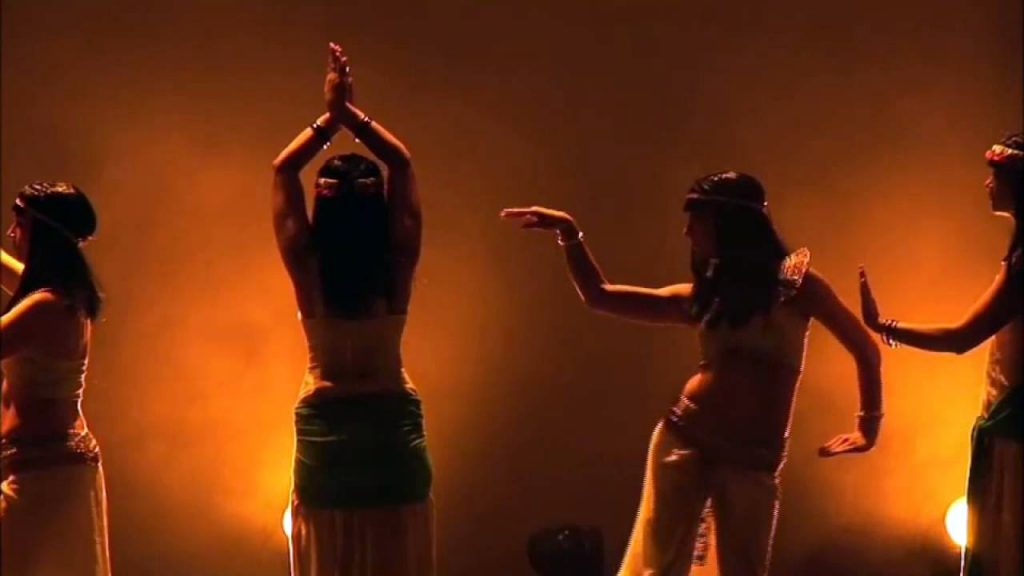
Dancers also often wore a lot of jewelries. And had strange hairdos with beads. Balls or cone-shaped tufts. In addition, accessories included boomerangs and gavel-headed sticks. The hieroglyph for heart was a dancing figure. The costumes of the dancer’s change. Depending on the context and the fashion of the time.
Types of Dance in Ancient Egypt
Dances were performed at births. Marriages, funerals, royal functions and ceremonies for the gods. Also, reliefs and murals depict children. Men, women, dwarfs, pygmies, kings and queens. Animals such as baboons and ostriches and gods like Thoth, Horus, Isis and Isis. Thay all were dancing. Hathor was the mistress of dance and music.
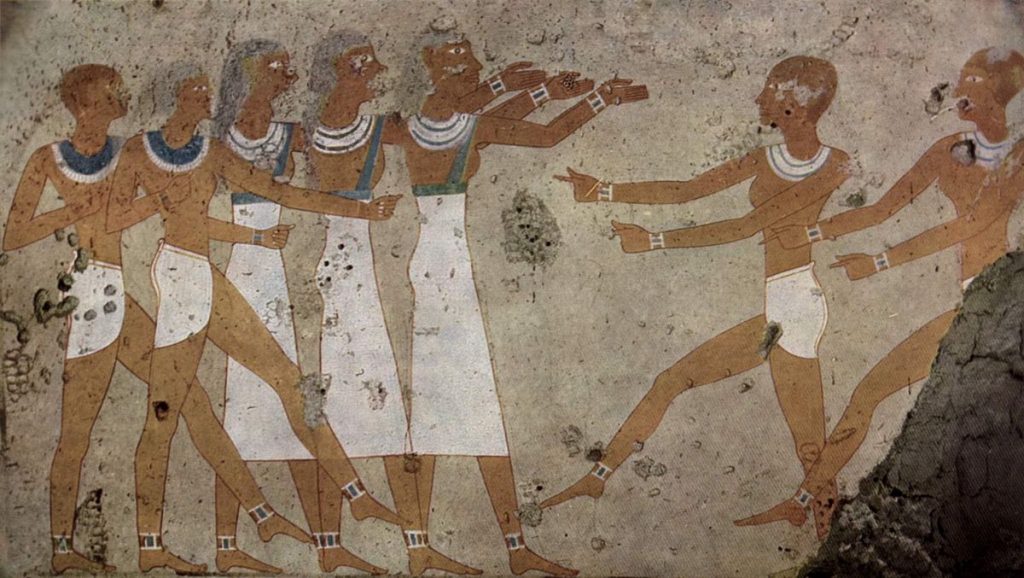
Seven females dancing on clapping fingers
Dance and music rhythms were provided by hand clapping, finger snapping, tambourines, drums and body slapping. Musicians played flutes, harps, lyres and clarinets. Vocalizations included songs, cries, choruses and rhythmic noises.
- The purely movement dance. A dance which was little more than an outburst of energy. Where the dancer and audience alike. Simply enjoyed the movement and its rhythm.
- The mirror dance from the Old Kingdom featured four dancers organized in pairs. Capturing the hand of Hathor. When the clappers clash. One boomerang dance featured young nude girls holding boomerangs. Organized in two concentric circles. Running in opposite directions.
- The gymnastic dance. Some dancers excelled at more strenuous and difficult movements. Which required training and great physical dexterity and flexibility. These dancers also refined their movements so as to move delicately.
- The pair dance. Pairs in ancient Egypt were forming by two men or by two women dancing together. Not by men dancing with women. The movements of these dancers executed in perfect symmetry. Indicating at least to the author of this treatise. The Egyptians were deeply conscious and serious about this dance. As something more than just movement.
- The imitative dance. These emulative of the movements of animals. Only obliquely referred to in Egyptian texts. While not actually represented in art.
- The war dances. These were apparently recreations for resting mercenary troops of Libyans. Sherdans, Pedtiu (peoples who formed parts of the so-called Sea Peoples) and other groups.
- The group dances. These fell into two sub-types. One taking place with perhaps at least four dancers. Sometimes as many as eight dancers. Each performing different movements, independent of each other but in matching rhythms. However, the other sub-type was the ritual funeral dance. And was performing by ranks of dancers executing identical movements.
- The dramatic dance. Several girls as performed to commemorate a historical view. kneeling girl represents a defeated enemy king, a standing girl the Egyptian king. Holding the enemy with one hand by the hair. And with the other a club.
- The lyrical dance. The description of this dance indicates it told its own story. Much as a ballet we may see today. A man and a girl dancing using wooden clappers. Which gave their steps rhythm danced in harmonious movement, separately or together. Sometimes pirouetting, parting, and approaching. The girl fleeing from the man, who tenderly pursued her.
- The religious dance. Temple rituals included musicians trained for the liturgy and singers. Trained in the hymns and other chants in ancient Egypt.
- The funeral dance. These formed three sub-types. One was the ritual dance, forming part of the actual funeral rite. In the second type, there were the expressions of grief. Where the performers placed their hands on their heads or made the ka gesture. Both arms upraised. The third sub-type was a dance to entertain the ka of the deceased.
Singers & Dancer
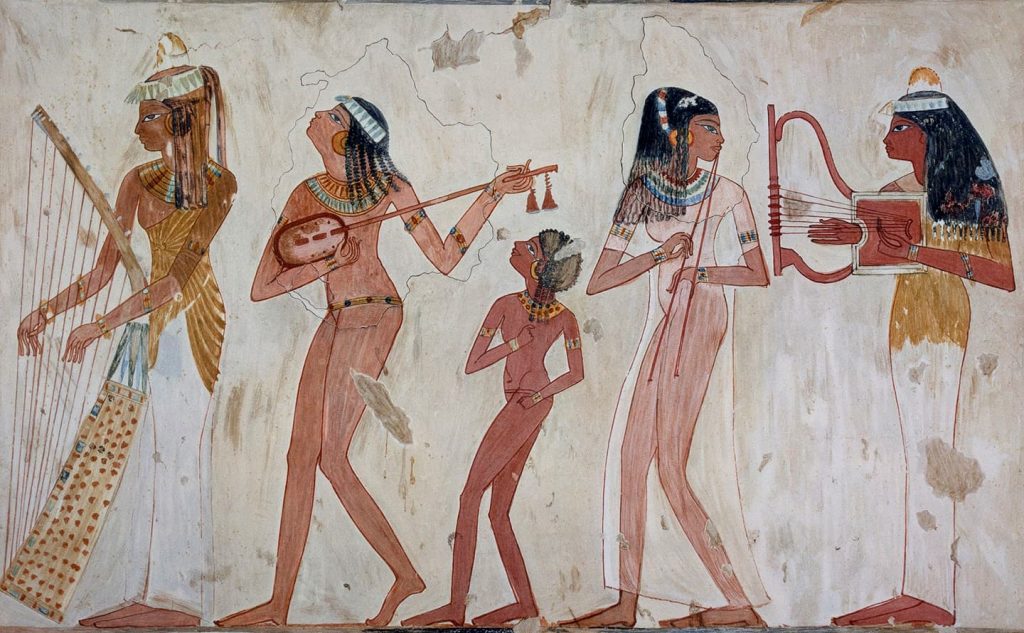
young women musicians and young girl dancer
Professional groups of singers (ḥsı͗t – kheset), musicians (ḥnı͗t or ḥnwt – khenet) and dancers (ḥbw – khebo) often performed at important festivals and funerary services. Basically, these groups referred to in the Old & Middle Kingdoms as the (ḫnr-khener) which translates to “musical performer”. Although, the main types of (ḫnr-khener). Thought to have existed are those associated with cults and temples, the king and funerary estates. The khener appear to dominate, and headed by females. Until the latter days of the Old Kingdom.
Gods & Religion
The Khener depicted as entertainers for religious ceremonies. Entertaining the deceased kings. But, the Khener may not be solely religious. In fact, khener used at the Temples of Hathor, Bat, and Horus. Some kheners were travelling from their permanent seat to offer their services as indicated in the story of Ruddedet. Therefore, dancers also took on work outside performances in order to support themselves.
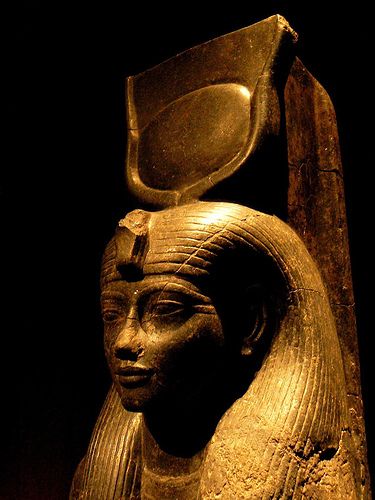
The Goddess Hathor, who also imbued the world with joy associated most closely with music. Initially it was another deity named Merit. In some versions of the creation story. Merit is present with Ra or Atum along with Heka. God of magic at the beginning of creation. To help establish order through music.
Egyptian religion celebrated the sensory pleasures of life. Moreover, believed to be among the Gods’ gifts to humanity. In addition, egyptians ate, drank, danced, and played music at their religious festivals. Also, they perfumed the air with flowers and incense. Many of Hathor’s description link her to celebration. She called the mistress of music, dance, garlands, myrrh, and drunkenness.
Ancient Egyptian build the pyramids of Giza to the sounds of music in the same way that people today listen to the radio while they work. Dancers appear on the wall’s tombs at this period. These dancers may have delighted Nikau during his lifetime. However, this celebration of specific dancers was unheard of. But, it does indicate the popular standing in which dancing held.
The King comes to dance, he comes to sing. Sovereign lady, see how he dances, Wife of Horus, see how he leaps
Music in Ancient Egypt
Professional musicians existed on a number of social levels. Perhaps the highest status belonged to temple musicians. In fact, the Egyptians loved music and included scenes of musical performances in tomb paintings and on temple walls. Similarly, it was the life style like today. However, professional musicians valued the dance equally and represented its importance as well.
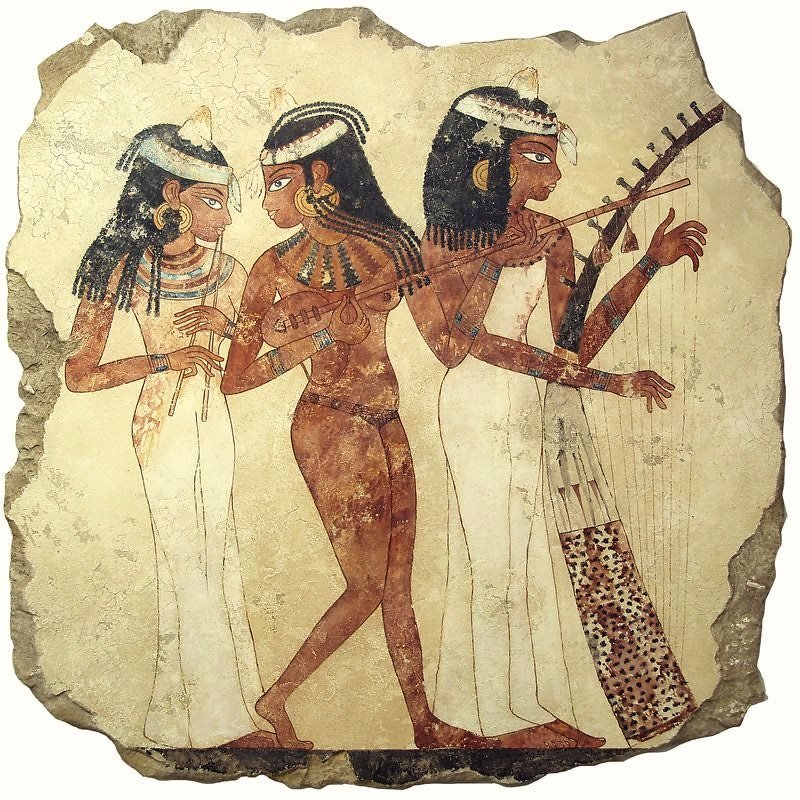
Somewhat lower on the social scale were musicians and dancers. Who acted as entertainers for parties and festivals. In fact, dance and music in ancient Egypt was so important at any social level. Because dance and music were a part of Egyptian life style back then.
They said the God Thoth invented the music in ancient Egypt and used it as a tool to civilize the world. In addition, the God Bes was singing and dancing to frighten away snakes and other evil entities away from women and children.
For the people. In fact, dance and music used for many purposes. Including entertainment in banquets. Religious rituals and war. Besides, the musicians usually performed in segregated same-sex groups, and they were musicians by profession. However, these bands would hired for banquets and rituals. So, they would sing and chat along with the music.
Instruments
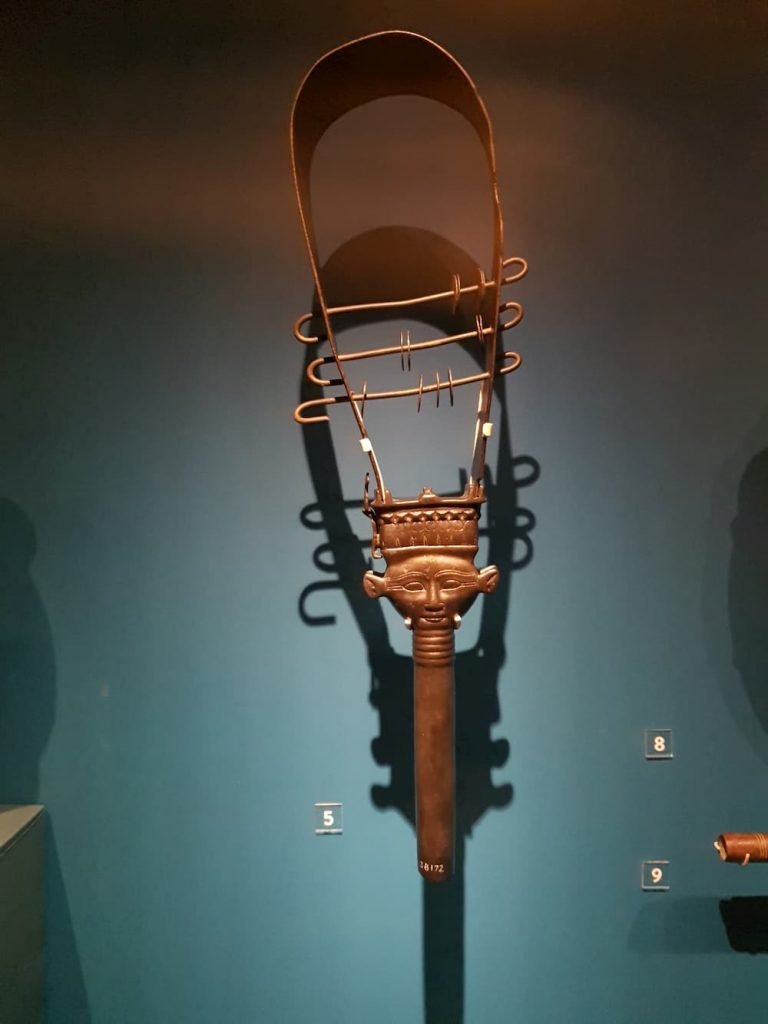
The instruments played in ancient Egypt are all familiar to people today. However, musicians played these either solo or in an ensemble just as today. So, most of Egyptian secular and religious life marked by the performance of music and dance in ancient Egypt.
The sistrum is a rattle like instrument was particularly important in Hathor’s worship. Because, sistra had erotic connotation. Alluded to the creation of new life and Hathor’s honor.
There are three basic types of musical instruments in Ancient Egypt
- Percussion instruments (drums, the sistrum, clappers, rattles, tambourines, bells and cymbals)
- String instruments (lyres, harps, and the lute is the original form of the Oud, which used in Egyptian music today).
- Wind instruments (the shepherd’s pipe, double-pipe, clarinet, flute, oboe, and trumpet). These instruments particularly associated with religious worship. The music used in these rites and ceremonies.
They would sometimes wear perfume cones on their heads. Also, they have weights tied to their hair. As a result, they would use it in their dance. They flick their hair from side to side. In fact, this is still a traditional form of dancing in some Arab countries. Dance and music were so important in many egyptian life even Egyptian God and godess
